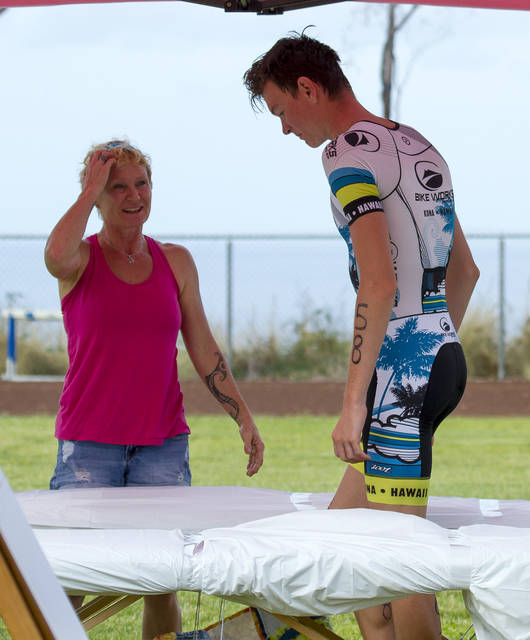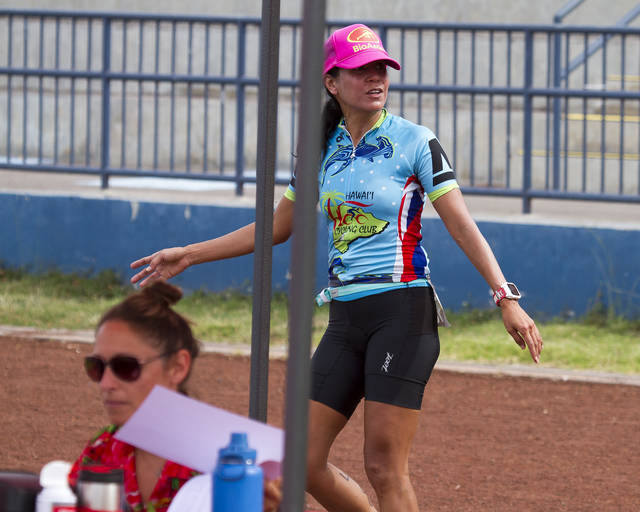Inaugural Powerman Hawaii off to modest, ‘fun’ start


KAILUA-KONA Every race has to start somewhere.
KAILUA-KONA — Every race has to start somewhere.
When the Ironman World Championships first came to Oahu in 1978 only 15 people competed in the event. When the inaugural Lavaman took place on the Big Island in 1999, only slightly more than 100 athletes finished the race.
ADVERTISING
Both the Ironman World Championship and Lavaman now have an attendance regularly in the 1,000s as they continue to grow both locally and globally.
This year it was Powerman’s turn to host its first Hawaii event. The global run-bike-run duathlon took place at Kealakehe High School on Sunday, which hosted about 30 athletes, down from the roughly 50 who originally signed up.
The low turnout is mostly due to the timing of Powerman, which takes place one week after the Hilo Marathon and one week before Lavaman. Only a dozen local athletes signed up.
A local athlete who did compete, Josiah Randerson, took first place overall with a time of 45 minutes, 16 seconds in the Sprint, a 2.5K run, 17K bike and 2.5K run. California’s Julie Cushen was the first female finisher in a time of 52:40.
“I had been looking forward to this event ever since I first heard about it way back in 2017,” Randerson said. “I know a lot of people were skeptical, but I knew it would be a good race.
“Seeing the amazing setup, a lot of people in the community really missed out, but it is the first year,” Randerson added. “It is only going to get bigger and bigger from here.”
Randerson has a lot of experience in duathlons, though not by choice.
“Every time I go to the mainland to compete it seems like they cancel the swim portion of the triathlon and it becomes a duathlon,” Randerson said with a laugh. “I have had only one race where they did not cancel the swim and they probably should have. The water was pretty rough that day.”
For Hilo’s Kelly Muragin, a member of the Hawaii Cycling Club, the run-bike-run format was perfect for her.
“I don’t really like to swim so this was my dream event,” she said. “It was definitely worth getting up and coming over from Hilo at 3 a.m.”
Muragin was the first female to cross the finish line in the short course, which featured a 28K bike in between a pair of 5K runs.
“The run was a little more challenging than I thought it would be with a lot of climbing,” Muragin said. “The bike was really fun except for the climb up Hina Lani. The course was also marked really well on the highway.”
While Muragin and the rest of the field seemed to have little trouble finding their way around the roads during the bike portion of the event, they did seem to struggle a little with the running loops around the campus.
Muragin got confused at the end of her race, starting another lap before realizing she was done. She then backtracked to the finishing shoot, but did not lose any place or much time.
Jeff Hambleton, who travels from Washington to Hilo for work on occasion, also had trouble with the running loops, but says he now believes he has it figured out for next year. Hambleton was the overall winner of the short course.
“All the turns and loops can be a little confusing but I liked the venue and loved the race,” Hambleton said. “I have been coming here since 2010 to do Honu and work at the Hilo Medical Center. Some friends of mine told me about this event, and being the inaugural event, I had to join in.”
The longest race of the day was The Classic, which included a 10K run, 56K bile and 10K run. Names and times of the Classic winners were not available by press times, along with times for the short course winners.
For Kealakehe High School athletic director Alan Vogt, who is working closely with Powerman to host the event, the whole process has been a learning experience.
“It has been very interesting,” Vogt said. “When they first approached me I did not realize the magnitude or scale of the event. There are several kinks we need to work out, but it is a great event and hopefully it will grow and grow.”
Powerman Hawaii was originally set for 2018, but was delayed due to road work on Queen Kaahumanu Highway.
All three races took runners around Kealakehe High School and then out onto Ane Keohokalole Highway. The course then dropped down on Palani Street to Queen Kaahumanu Highway before heading back up Hina Lani Street to Anne Keohokalole and back to Kealakehe.
The 8.5-mile loop was repeated until each race was completed.
The event also serves as a fundrasier for Kealakehe. A portion of each entry fee is given back to the school to help fund their athletic programs and extracurricular clubs.
“We don’t expect much right away,” Vogt said. “Baby steps first, but I expect a good working relationship with Powerman.”
This was Powerman’s smallest field for an event this year. Most Powerman events range from as few as 200 athletes to more than 2,000 competitors at some of the larger events.


